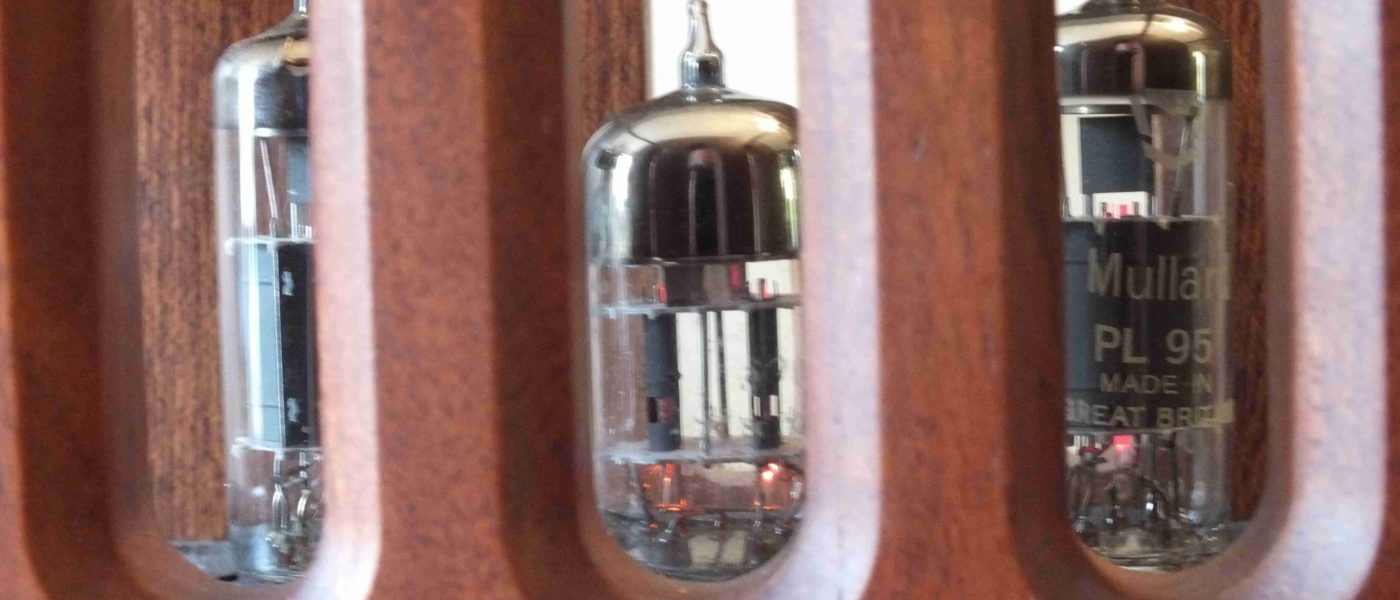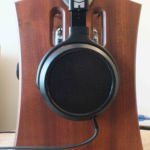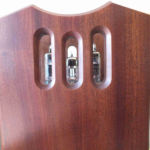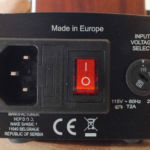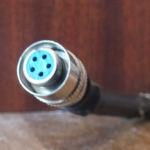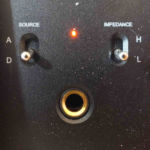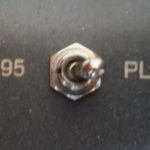Auris Euterpe DAC/AMP
Packaging / Kit:
I received the tour model Euterpe which came in generic packaging so cant speak to the retail package. The tour model ships with the unit, a set of EI tubes, and the power block. It did not ship with a power cord, but a standard C14 receptacle is used on the power supply so a standard C13 or C15 power cord is all that is needed to round out the package. In a pinch, a standard computer power cord will fit although I do recommend using something a bit better shielded.
Build:
The Euterpe is both beautiful and functional. The wooden outer panels are straight grained but well stained to show the figured they do have. The windows through the panels put the tubes on full display, and the internals tuck neatly into the middle where they disappear into the background and just let you enjoy. The function as a headphone stand makes the Euterpe strangely utilitarian for such a high end piece of hardware. Controls are well done with switches being very positive and the volume knob having good weight as it doesn’t take effort to turn but doesn’t feel like it is going to fly out from under one’s fingers either. Front controls include the source switch for pre-amp input from an external DAC or direct USB input using the internal DAC, an impedance switch (below 150Ω vs above), and the volume knob which doubles as the power on/off. The reverse has two sets of RCAs at top (One in, one out) a USB A female port, and a proprietary power connector. At the top behind the three tube sockets, another switch handles voltage supplied to the tube heaters. In the EL95 position 6.3 Volts is supplied. In the PL95 position that voltage is reduced to 4.5 Volts. The power brick itself is exactly that. It is literally the size and weight of (at least) a brick and does a good job of providing clean power to the Euterpe. My tools to test it are limited but putting it on a scope showed very clean power. The cable from the brick is nearly 5 feet in length allowing for good separation of the power supply from the unit to avoid interference. The cord is cloth wrapped with a proper strain relief as it exits the unit and should give years of trouble free service. The power brick does get warm but is heatsinked both internally and by the case and even after 24 hours of continuous use it is only warm to the touch. Also worth noting, the lack of a provided power cord allows users to adapt the Euterpe to their local voltage (easily switched between 110 and 240) and connector types.
Internals:
The Euterpe is composed of a xmos chip that handles USB input duties, a Sabre ES9018 chip handles the conversion duties, a 12AT7 tube handles pre-amp functions with a Mundorf capacitor in line between the pre-amp and power tubes. A customized alps potentiometer handles volume adjustment, and either PL95 or EL95 tubes handle the power duties. The Euterpe is a output transformer designed amp, but additional details about the make and model of transformer used have not been published by the Auris that I can find. The DAC chip is capable of higher resolutions than the xmos input allows so the limits are effectively set by the USB implementation. DSD64 and 128 are supported and PCM maxes out at 32/384. Measured output is 0.9Watts.
The tubes make a major contribution to the sound of the Euterpe, and allow the owner to customize the sound to their liking and their headphones. The pre-amp is the ECC81 or in western vernacular, the 12AT7. This is a very common tube used in a ton of guitar amps as well as audiophile applications. The 12A_7 family of tubes allows the user to substitute other members of the family to boost or lower the overall gain. Auris mentions use of the ECC82 (12aU7) with sensitive headphones. Mμ of the au7 is 17 vs the at7’s mμ of 70 so swapping in a 12au7 will certainly lower the noise floor and the overall output power and there are alot of really good 12au7s out there at reasonable prices. Conversely, if you really wanted to increase output power swapping in a 12aX7 with a mμ of 100 will certainly do so. Noise floor is raised considerably by doing so and is probably only useful when attempting to power something like the He6se.
The stock tubes are the EI Yugoslavian made current production PL95 power tubes and a Electro-Harmonix Russian made 12AT7 pre-amp tube. These have respectable performance but limit the overall dynamics of the Euterpe and some notes I have seen to date seem to be more of a critique of the limits of the tubes than of the device. For my testing I first listened to the stock tubes, then went digging through my stash and found a couple GE 5-star 6201s, a Brimar CV4024, and a Telefunken Diamond 6211 to try in the pre-amp spot. For power tubes, I had Siemans, Mullard, and RCA PL95s along with a few Mullard and Valvo EL95s on hand. I came away with the feeling that the power tubes influenced how cleanly the details were presented but the largest changes came when swapping pre-amp tubes. I could live with the stock PL95s if the pre-amp tube is swapped for any of those listed as it dramatically improved the dynamics and brought better midrange performance. The best value among the bunch is likely the GE 6201 which can be found in the $20-$50 range depending on what age and type. The one I used was an early tube with black plates and triple Mica and is one of the harder versions to find, but well worth the hunt in my estimation. Ok, I’ll save you the hunt, last I looked Brent Jessee had the 6201 here and the one you want is this one ( 12AT7WA 6201 / GL6201 GE blackplate 5-STAR, Military Grade and 5-star). PL and EL 95 tubes are a bit harder to turn up a reliable source so, some scrounging may be needed but ,if you can find the Mullard (early british made) PL95s, I think they provide the best dynamics of the bunch.
One quick reminder, if switching power tubes, make certain the top switch is in the proper position before powering on the amp. The only difference in PL and EL 95 tubes is the heater voltage/current required so feeding a PL tube the voltage intended for an EL will likely dramatically shorten the life of the tube if not turn it into a flashbulb immediately.
Sound:
I have to divide this into three component discussions when speaking of the sound of the Euterpe. Part one is the internal DAC performance vs using an external DAC to feed the unit. Part two is using the stock tubes in the Amp, and part three is tube rolling the amp which changes it pretty dramatically. For purposes of reviewing the Euterpe, I used the HD800, He560, and Empire Ears ESR (borrowed – thanks Jeff).
The internal dac leans slightly to the bright side which makes it sound clean and slightly cool because it really doesn’t introduce any warmth to the recording. I don’t want to give the impression that the Euterpe is overly bright as it isn’t but the DAC contribution is slightly bright and cool and does a good job of balancing the warmth usually added by the Amp stage. I think a warm on warm design might be too much of a good thing and so appreciate the tuning for a more middle ground result. Detail is quite good, but not in the league with something like the Burson Swing and details and transients are improved by moving to an external DAC. The Swing offers a similar tonality to the internal DAC with a bit of a step up in resolution. By contrast, the Bifrost MB when paired to the Euterpe sounds a bit warmer and thicker than either the internal dac or the Swing. Overall, I was impressed with the internal dac implementation and surprised that the differences between the 9018 and 9038 in the swing were not considerably larger. While some of the telltale signs of the ESS chip are still on display, the tubes do a good job at balancing what can be a cold, clinical, precise sound with a bit of needed warmth and smoothness.
Stock tubes offer good performance but can almost always be improved upon depending on the pairing involved. The Stock pre-amp tube lacks a bit of dynamic range when compared to others and could deceive the user into thinking the unit is also equally limited. The stock power tubes are less of an issue and when trading them out for other models, I found that the most obvious change was in the speed of bass presented.
Tube rolling offers several advantages, the first of which is tuning the noise floor. The Euterpe is fairly quiet (particularly for a SET) but can be made even more so by swapping in a 12au7 for the pre-amp tube. With the stock tube (12at7) I could hear a hiss when using sensitive iems. Most of the time it was only evident when music was off, but on a few like the Magaosi K5 it could be heard during playback. With a 12au7 (I used an easy to find Amperex Bugle Boy) dropped the noise floor to dead quiet with the K5, but did also reduce the usable volume range with the HD800s. For HD800s, tweaking the sound by swapping in better quality tubes improved the sound overall. My preference was a Brimar CV4024 with the GE 5-star 6201 coming in a close 2nd. These improved the dynamics and the tonality of the mids.
I have made several comments regarding improving the Euterpe which one might mistake for suggesting it doesn’t sound good out of the box. That is absolutely untrue as I found the tonality of the Euterpe fantastic and the voicing was very good when paired with the HD800. SWMBO who usually ignores my gear and only occasionally listens to something to placate me put on the HD800 and listened to Fleetwood Mac – Go Insane and immediately turned to me and said “You should buy that one”. What can I say, she has good taste even if marrying me might suggest to the contrary.
Conclusions:
I have to say at the outset, when you price a product at $1800 USD and you name it after the greek goddess of music and “giver of delight”, you’d better deliver or the thud of your product hitting the floor is going to be deafening. I was skeptical that a device that was as much headphone stand as it was dac/amp really could deliver the goods. It was already hamstrung by using a Sabre DAC, and a lower end one at that, so I knew the Sabre glare would be on full display. Guess what, I was wrong. Yep, it happens. Tonality is gorgeous with none of the treble harshness I expected and with the appropriate tube swaps, the background is as quiet as I have heard in a SET. While the DAC doesn’t quite wring out the detail of some others, it does a very respectable job and may be the best ESS 9018 implementation I have heard to date. The Euterpe is as emotional and expressive as it is gorgeous to look at. It really does seem to bring out the best in a recording and is more forgiving than I expected.
Power is very good while not being so high that it prevents use of IEMs or so low that big planars are a no-go. It is more versatile than many all in one units due to the use of the 12a_7 family of pre-amp tubes that let the end user vary the Mμ from 17 to 100 depending on which member of the family is in use. The design of the cabinetry to double as a headphone stand is also one of those things that is so simple its almost hard to believe it hasn’t been done before (I know Kennerton did it and loaned it to Auris). It makes infinite sense and using well figured hardwoods makes the mixture of wood and glass as much art on the desk as it is functional.
I’ll also admit that I took SWMBO’s advice and bought the Euterpe so this one won’t be leaving my collection. That is probably the largest complement I can give it.
Rankings are based on stock tube set. Adding higher quality tubes (particularly the pre-amp) can boost scores as much as a full point.
(Side note: This tour unit was damaged in shipping and the metal base plate pulled loose from the wood. I removed it as the unit did not sit level with the base attached. I feel compelled to state that the packing job and subsequent issue were not the fault of Auris as it was shipped in something other than the original packing and mishandled by the Freight company as the box appears to have either conveyor or tire tracks on it).
-
Build Quality - 8.5/108.5/10
-
Sound Quality - 7/107/10
-
Soundstage - 8/108/10
-
Imaging - 8/108/10
Summary
Pros – very expressive and emotional sounding with better DAC implementation than expected.
Cons – USB Only, no optical or coaxial inputs, limited by quality of tubes available.

